 Soyuz 36 is launched by the Soviet Union on a one-week mission to space station Salyut 6. The crew consists of Apollo-Soyuz veteran Valery Kubasov and the first Hungarian in space, Bertalan Farkas. During the crew’s week-long visit to Salyut 6, they undertake an exhaustingly jam-packed series of experiments before swapping Soyuz vehicles with the long-duration station crew – technically, the Soyuz 36 crew returns in the Soyuz 35 vehicle on June 6th.
Soyuz 36 is launched by the Soviet Union on a one-week mission to space station Salyut 6. The crew consists of Apollo-Soyuz veteran Valery Kubasov and the first Hungarian in space, Bertalan Farkas. During the crew’s week-long visit to Salyut 6, they undertake an exhaustingly jam-packed series of experiments before swapping Soyuz vehicles with the long-duration station crew – technically, the Soyuz 36 crew returns in the Soyuz 35 vehicle on June 6th.

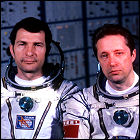 An advanced version of a new Soviet Soyuz spacecraft is launched with a crew for the first time. Soyuz T-2 is launched on a three-day mission to visit the Salyut 6 space station, with its primary goal to test a new automated approach and docking system for use with the Salyut space stations. After spending almost four days in orbit, cosmonauts Yuri Malyshev and Vladimir Aksyonov return to Earth; due to their vehicle’s flight test status, the T-2 crew does not swap spacecraft with the Salyut 6/Soyuz 35 crew.
An advanced version of a new Soviet Soyuz spacecraft is launched with a crew for the first time. Soyuz T-2 is launched on a three-day mission to visit the Salyut 6 space station, with its primary goal to test a new automated approach and docking system for use with the Salyut space stations. After spending almost four days in orbit, cosmonauts Yuri Malyshev and Vladimir Aksyonov return to Earth; due to their vehicle’s flight test status, the T-2 crew does not swap spacecraft with the Salyut 6/Soyuz 35 crew.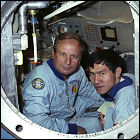 The Soviet Union launches Soyuz 37 on a week-long mission to visit space station Salyut 6. Part of the Interkosmos series, Soyuz 37 carries an international crew consisting of veteran cosmonaut Viktor Gorbatko and the first Vietnamese space traveler, Pham Tuan. Joint experiments are conducted with the long-duration crew of Salyut 6/Soyuz 35, and the Soyuz 37 crew departs in the Soyuz 36 capsule on July 31st, leaving the station crew with a fresh vehicle with which to make their own return home.
The Soviet Union launches Soyuz 37 on a week-long mission to visit space station Salyut 6. Part of the Interkosmos series, Soyuz 37 carries an international crew consisting of veteran cosmonaut Viktor Gorbatko and the first Vietnamese space traveler, Pham Tuan. Joint experiments are conducted with the long-duration crew of Salyut 6/Soyuz 35, and the Soyuz 37 crew departs in the Soyuz 36 capsule on July 31st, leaving the station crew with a fresh vehicle with which to make their own return home. The Soviet Union launches Soyuz 38 on a mission to the Salyut 6 space station, carrying cosmonaut Yuri Romanenko and the first Cuban in space, Arnaldo Tamayo Mendez. The week-long flight includes docking maneuvers with Salyut 6 in pitch blackness, guided only by the lights on both the Soyuz vehicle and the station, and experiments aboard Salyut. Since the long-duration Salyut 6/Soyuz 35 crew is due to leave the station soon, the Soyuz 38 crew departs in the same vehicle in which it arrived.
The Soviet Union launches Soyuz 38 on a mission to the Salyut 6 space station, carrying cosmonaut Yuri Romanenko and the first Cuban in space, Arnaldo Tamayo Mendez. The week-long flight includes docking maneuvers with Salyut 6 in pitch blackness, guided only by the lights on both the Soyuz vehicle and the station, and experiments aboard Salyut. Since the long-duration Salyut 6/Soyuz 35 crew is due to leave the station soon, the Soyuz 38 crew departs in the same vehicle in which it arrived.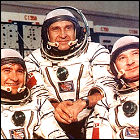 Soyuz T-3 lifts off from the Soviet Union’s Baikonur Cosmodrome launch complex, carrying the first three-man Soviet space crew since the early days of the Soyuz in 1971. Cosmonauts Leonid Kizim, Oleg Makarov and Gennady Strekalov also become the first three-man space station crew since the ill-fated crew of the first Salyut. Over a period of nearly two weeks, the crew conducts extensive repairs and upgrades to Salyut 6, readying the station for its next long-duration crew before departing on December 10th.
Soyuz T-3 lifts off from the Soviet Union’s Baikonur Cosmodrome launch complex, carrying the first three-man Soviet space crew since the early days of the Soyuz in 1971. Cosmonauts Leonid Kizim, Oleg Makarov and Gennady Strekalov also become the first three-man space station crew since the ill-fated crew of the first Salyut. Over a period of nearly two weeks, the crew conducts extensive repairs and upgrades to Salyut 6, readying the station for its next long-duration crew before departing on December 10th.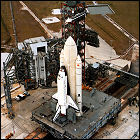 For the first time in the history of the delay-riddled Space Shuttle program, a complete, flight-ready vehicle is rolled out to the launch pad. Space Shuttle Columbia, atop the modified crawler vehicle which once carried Saturn V rockets to the pad, arrives at Cape Canaveral Launch Complex 39A, strapped to flight-qualified solid rocket boosters and a flight-ready external tank. (The shuttle Enterprise had been attached to empty boosters and tanks for fit checks as early as 1979.) Though preparation work continues to ready Columbia for flight, the shuttle is now in position for her first launch in 1981.
For the first time in the history of the delay-riddled Space Shuttle program, a complete, flight-ready vehicle is rolled out to the launch pad. Space Shuttle Columbia, atop the modified crawler vehicle which once carried Saturn V rockets to the pad, arrives at Cape Canaveral Launch Complex 39A, strapped to flight-qualified solid rocket boosters and a flight-ready external tank. (The shuttle Enterprise had been attached to empty boosters and tanks for fit checks as early as 1979.) Though preparation work continues to ready Columbia for flight, the shuttle is now in position for her first launch in 1981.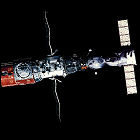 The Soyuz T-4 mission lifts off from the Soviet Union, carrying a two-man crew to space station Salyut 6. Cosmonauts Vladimir Kovalyonok and Viktor Savinykh remain about the station for 75 days, and are the last long-duration crew to occupy Salyut 6. Since they are still in orbit in April, they become the first Soviet crew to orbit the Earth at the same time as an American manned space vehicle since 1975, though the two never interact with each other at any point. The Soyuz T-4 capsule remains at the station as the escape vehicle until this crew departs in May.
The Soyuz T-4 mission lifts off from the Soviet Union, carrying a two-man crew to space station Salyut 6. Cosmonauts Vladimir Kovalyonok and Viktor Savinykh remain about the station for 75 days, and are the last long-duration crew to occupy Salyut 6. Since they are still in orbit in April, they become the first Soviet crew to orbit the Earth at the same time as an American manned space vehicle since 1975, though the two never interact with each other at any point. The Soyuz T-4 capsule remains at the station as the escape vehicle until this crew departs in May.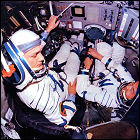 Soyuz 39 lifts off from the Soviet Union, carrying its two-man crew on a week-long spaceflight including a visit to space station Salyut 6. The crew consists of cosmonauts Vladimir Dzhanibekov and Jugderdemidiin Gurragchaa, the first Mongolian in space. In conjunction with the resident Salyut 6/Soyuz T-4 crew, they conduct scientific and engineering experiments, some of them studying the state of Salyut 6 after several years in orbit. The Soyuz 39 crew returns to Earth on March 30th.
Soyuz 39 lifts off from the Soviet Union, carrying its two-man crew on a week-long spaceflight including a visit to space station Salyut 6. The crew consists of cosmonauts Vladimir Dzhanibekov and Jugderdemidiin Gurragchaa, the first Mongolian in space. In conjunction with the resident Salyut 6/Soyuz T-4 crew, they conduct scientific and engineering experiments, some of them studying the state of Salyut 6 after several years in orbit. The Soyuz 39 crew returns to Earth on March 30th. The first attempt to launch Space Shuttle Columbia on her maiden voyage is called off due to problems with the shuttle’s sophisticated system of redundant flight computers, some of which fail to synchronize with each other during the countdown. Over 24 hours are required to fix the bug, and the launch is delayed by two days.
The first attempt to launch Space Shuttle Columbia on her maiden voyage is called off due to problems with the shuttle’s sophisticated system of redundant flight computers, some of which fail to synchronize with each other during the countdown. Over 24 hours are required to fix the bug, and the launch is delayed by two days.
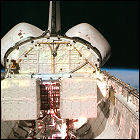 Safely in orbit, the cargo bay doors are opened for the first time on
Safely in orbit, the cargo bay doors are opened for the first time on 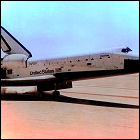 The first shuttle to return from space,
The first shuttle to return from space, 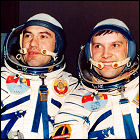 The final first-generation Soyuz spacecraft, Soyuz 40, is launched on a week-long spaceflight by the Soviet Union. With Leonid Popov and Romanian cosmonaut Dumitru Prunariu aboard, Soyuz 40 visits space station Salyut 6 for several days, and is the last spacecraft to dock at the five-year-old space station. The Soyuz 40 crew returns to Earth on May 22nd. Future Soyuz launches will use the upgraded Soyuz-T vehicles.
The final first-generation Soyuz spacecraft, Soyuz 40, is launched on a week-long spaceflight by the Soviet Union. With Leonid Popov and Romanian cosmonaut Dumitru Prunariu aboard, Soyuz 40 visits space station Salyut 6 for several days, and is the last spacecraft to dock at the five-year-old space station. The Soyuz 40 crew returns to Earth on May 22nd. Future Soyuz launches will use the upgraded Soyuz-T vehicles.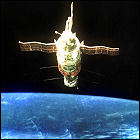 Launched unmanned in April, the Kosmos 1267 space station module docks automatically with the recently vacated Salyut 6 space station – the first-ever on-orbit expansion of a previously launched space structure. The module, a hardware holdover from the abandoned Almaz military space station program, provides engineers on the ground with information needed to safely add modules to the upcoming Salyut 7 space station to expand its habitable space. The experience gained will also be instrumental in the construction of the Mir station and the International Space Station. Kosmos 1267 remains docked to Salyut 6 until the combined structure tumbles out of orbit in 1982.
Launched unmanned in April, the Kosmos 1267 space station module docks automatically with the recently vacated Salyut 6 space station – the first-ever on-orbit expansion of a previously launched space structure. The module, a hardware holdover from the abandoned Almaz military space station program, provides engineers on the ground with information needed to safely add modules to the upcoming Salyut 7 space station to expand its habitable space. The experience gained will also be instrumental in the construction of the Mir station and the International Space Station. Kosmos 1267 remains docked to Salyut 6 until the combined structure tumbles out of orbit in 1982.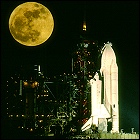 The second launch of Space Shuttle Columbia gets an unexpected one-month delay when a fuel leak forces NASA to remove, clean and re-attach 300 thermal tiles. The work can be done on-site, so Columbia simply stays on the pad. The second launch will be the last for the white external fuel tank, since NASA has determined that its brown insulating foam layer will cause no problems if left exposed; leaving off the coat of white paint saves several hundred pounds.
The second launch of Space Shuttle Columbia gets an unexpected one-month delay when a fuel leak forces NASA to remove, clean and re-attach 300 thermal tiles. The work can be done on-site, so Columbia simply stays on the pad. The second launch will be the last for the white external fuel tank, since NASA has determined that its brown insulating foam layer will cause no problems if left exposed; leaving off the coat of white paint saves several hundred pounds. For the first time in history, a space vehicle returns to space for a second complete mission.
For the first time in history, a space vehicle returns to space for a second complete mission. 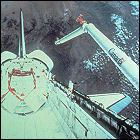 Key to NASA’s claim that the
Key to NASA’s claim that the 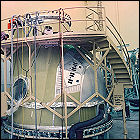 At Rockwell International, a spare Space Shuttle crew module is assembled alongside components intended for the orbiters Discovery and Atlantis, and though the spare isn’t intended for a specific shuttle yet to be built, it will find a purpose in the wake of the 1986 Challenger disaster: the spare crew module will become one of many completed shuttle spares that will eventually be assembled in the late 1980s as the Space Shuttle Endeavour, Challenger’s replacement and the last space shuttle constructed.
At Rockwell International, a spare Space Shuttle crew module is assembled alongside components intended for the orbiters Discovery and Atlantis, and though the spare isn’t intended for a specific shuttle yet to be built, it will find a purpose in the wake of the 1986 Challenger disaster: the spare crew module will become one of many completed shuttle spares that will eventually be assembled in the late 1980s as the Space Shuttle Endeavour, Challenger’s replacement and the last space shuttle constructed.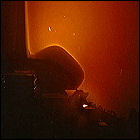 The testing phase of the shuttle program continues as Space Shuttle Columbia lifts off for her third flight into space. With Commander Jack Lousma and Pilot C. Gordon Fullerton aboard, Columbia stays in orbit for over a week, testing the orbiter’s endurance to heat at different angles to the sun, as well as testing the unmanned Spacelab experiment pallets in the cargo bay. This is the first shuttle flight to end on the contingency landing site at White Sands, New Mexico.
The testing phase of the shuttle program continues as Space Shuttle Columbia lifts off for her third flight into space. With Commander Jack Lousma and Pilot C. Gordon Fullerton aboard, Columbia stays in orbit for over a week, testing the orbiter’s endurance to heat at different angles to the sun, as well as testing the unmanned Spacelab experiment pallets in the cargo bay. This is the first shuttle flight to end on the contingency landing site at White Sands, New Mexico.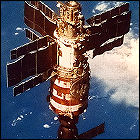 The Soviet Union launches the last of the Salyut space stations, Salyut 7, into Earth orbit. Reflecting an ongoing significant rethink on space station construction, Salyut 7 is intended from the outset to be docked with additional modules to expand its habitable and working space. It also sets a new endurance record of its own, remaining in orbit for nearly a decade.
The Soviet Union launches the last of the Salyut space stations, Salyut 7, into Earth orbit. Reflecting an ongoing significant rethink on space station construction, Salyut 7 is intended from the outset to be docked with additional modules to expand its habitable and working space. It also sets a new endurance record of its own, remaining in orbit for nearly a decade.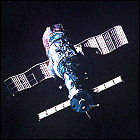 Soyuz T-5 lifts off from the Soviet Union, carrying its crew of two to the new Salyut 7 space station for a long-term stay. Cosmonauts Anatoli Berezovoy and Valentin Lebedev become Salyut 7’s first occupants, remaining aboard the station for a record-setting 211 days (almost seven months), not returning until December 1982. During that time, the two cosmonauts host two other visiting crews and launch a small amateur radio communications satellite by ejecting it from a small airlock.
Soyuz T-5 lifts off from the Soviet Union, carrying its crew of two to the new Salyut 7 space station for a long-term stay. Cosmonauts Anatoli Berezovoy and Valentin Lebedev become Salyut 7’s first occupants, remaining aboard the station for a record-setting 211 days (almost seven months), not returning until December 1982. During that time, the two cosmonauts host two other visiting crews and launch a small amateur radio communications satellite by ejecting it from a small airlock. The Soviet Union launches a scaled-down test model of a compact space shuttle design into orbit, part of an ultimately abandoned study of a vehicle design called Spiral. The BOR4 structural test article is photographed being recovered from the Indian Ocean by the Australian government, revealing the design to the western world for the first time. NASA begins a study of the BOR4 lifting body design, finding that it has a stable flight profile and unusually good reentry and landing characteristics, and though NASA’s version of the vehicle, HL20, is later mooted as a shuttle replacement, both countries’ space agencies pass on the design, which will later be revived by Sierra Nevada Corporation as the Dream Chaser. BOR4 is launched three more times through 1984, at which point the Soviets instead press ahead with development of
The Soviet Union launches a scaled-down test model of a compact space shuttle design into orbit, part of an ultimately abandoned study of a vehicle design called Spiral. The BOR4 structural test article is photographed being recovered from the Indian Ocean by the Australian government, revealing the design to the western world for the first time. NASA begins a study of the BOR4 lifting body design, finding that it has a stable flight profile and unusually good reentry and landing characteristics, and though NASA’s version of the vehicle, HL20, is later mooted as a shuttle replacement, both countries’ space agencies pass on the design, which will later be revived by Sierra Nevada Corporation as the Dream Chaser. BOR4 is launched three more times through 1984, at which point the Soviets instead press ahead with development of 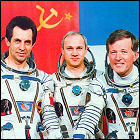 The Soviet Union launches the Soyuz T-6 mission on a week-long flight into orbit, including a visit to space station Salyut 7. Cosmonauts Vladimir Dzhanibekov, Aleksandr Ivanchenkov and Jean-Loup Chretien – the latter being the first Frenchman in space – spend several days aboard Salyut 7 performing experiments. Chretien would fly on later missions aboard Mir and the American Space Shuttle.
The Soviet Union launches the Soyuz T-6 mission on a week-long flight into orbit, including a visit to space station Salyut 7. Cosmonauts Vladimir Dzhanibekov, Aleksandr Ivanchenkov and Jean-Loup Chretien – the latter being the first Frenchman in space – spend several days aboard Salyut 7 performing experiments. Chretien would fly on later missions aboard Mir and the American Space Shuttle. Space Shuttle Columbia lifts off for the fourth and final shuttle “test flight” before NASA’s Space Transportation System is declared fully operational. Remaining in orbit for a full week, Commander Ken Mattingly and Pilot Henry Hartsfield deliver the shuttle program’s first payload for the Department of Defense, as well as some of the first student-submitted experiment packages flown in the shuttle program. Both of Columbia’s solid rocket boosters, which are considered a reusable part of the launch vehicle, are lost at sea when their parachutes fail to deploy after separation and the boosters slam into the Atlantic Ocean; neither of the rockets are able to be recovered.
Space Shuttle Columbia lifts off for the fourth and final shuttle “test flight” before NASA’s Space Transportation System is declared fully operational. Remaining in orbit for a full week, Commander Ken Mattingly and Pilot Henry Hartsfield deliver the shuttle program’s first payload for the Department of Defense, as well as some of the first student-submitted experiment packages flown in the shuttle program. Both of Columbia’s solid rocket boosters, which are considered a reusable part of the launch vehicle, are lost at sea when their parachutes fail to deploy after separation and the boosters slam into the Atlantic Ocean; neither of the rockets are able to be recovered.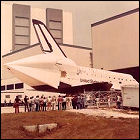 Completely refitted from a lightweight airframe originally fabricated for stress, vibration and thermal testing, Space Shuttle Challenger is rolled out of her Rockwell International assembly plant in Palmdale, California. Experience gained in the construction of Challenger’s sister ship, Columbia, means that the second completed shuttle in the fleet is over one ton lighter than Columbia. Challenger would make her first flight in just under a year.
Completely refitted from a lightweight airframe originally fabricated for stress, vibration and thermal testing, Space Shuttle Challenger is rolled out of her Rockwell International assembly plant in Palmdale, California. Experience gained in the construction of Challenger’s sister ship, Columbia, means that the second completed shuttle in the fleet is over one ton lighter than Columbia. Challenger would make her first flight in just under a year.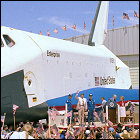 Space Shuttle Columbia lands at Edwards Air Force Base in California, making its first-ever landing on a concrete runway. After greeting the returning astronauts and inspecting the shuttle, President Ronald Reagan – with the partially-dismantled prototype Enterprise as a backdrop – declares NASA’s Space Shuttle system fully operational, saying “the test flights are over.” Columbia Commander Ken Mattingly later reveals that there was tremendous pressure on NASA to land Columbia on Independence Day, regardless of how many mission objectives had been met, to maximize the publicity value of the President’s speech. But the quick turnaround time and almost-weekly flight schedule that NASA had publicized throughout the 1970s is already a pipe dream: post-mission the four missions flown so far prove that post-landing servicing of each orbiter takes longer than expected. Columbia won’t fly again until the first “operational” mission in November.
Space Shuttle Columbia lands at Edwards Air Force Base in California, making its first-ever landing on a concrete runway. After greeting the returning astronauts and inspecting the shuttle, President Ronald Reagan – with the partially-dismantled prototype Enterprise as a backdrop – declares NASA’s Space Shuttle system fully operational, saying “the test flights are over.” Columbia Commander Ken Mattingly later reveals that there was tremendous pressure on NASA to land Columbia on Independence Day, regardless of how many mission objectives had been met, to maximize the publicity value of the President’s speech. But the quick turnaround time and almost-weekly flight schedule that NASA had publicized throughout the 1970s is already a pipe dream: post-mission the four missions flown so far prove that post-landing servicing of each orbiter takes longer than expected. Columbia won’t fly again until the first “operational” mission in November. The Soviet Union’s Soyuz T-7 mission lifts off from Baikonur Cosmodrome for a week-long stay in space, including a visit to space station Salyut 7. The three-person Soyuz crew includes the first woman in space since 1963. Cosmonauts Leonid Popov, Aleksandr Serebrov and Svetlana Savitskaya deliver supplies to Salyut 7 and perform experiments while docked to the station; on August 27th, they depart from the station aboard the Soyuz T-5 vehicle, leaving the newer T-7 capsule for the station crew’s use.
The Soviet Union’s Soyuz T-7 mission lifts off from Baikonur Cosmodrome for a week-long stay in space, including a visit to space station Salyut 7. The three-person Soyuz crew includes the first woman in space since 1963. Cosmonauts Leonid Popov, Aleksandr Serebrov and Svetlana Savitskaya deliver supplies to Salyut 7 and perform experiments while docked to the station; on August 27th, they depart from the station aboard the Soyuz T-5 vehicle, leaving the newer T-7 capsule for the station crew’s use. On the first fully-operational flight of NASA’s Space Transportation System, Space Shuttle Columbia delivers two commercial satellites to orbit, the Canadian Anik C-3 satellite and an American satellite, SitS-C. Aboard Columbia for this flight is the first four-astronaut crew in NASA’s history, consisting of Commander Vance Brand, Pilot Robert Overmyer, and mission specialists Joseph Allen and William Lenoir. The flight lasts five days before a landing at Edwards Air Force Base.
On the first fully-operational flight of NASA’s Space Transportation System, Space Shuttle Columbia delivers two commercial satellites to orbit, the Canadian Anik C-3 satellite and an American satellite, SitS-C. Aboard Columbia for this flight is the first four-astronaut crew in NASA’s history, consisting of Commander Vance Brand, Pilot Robert Overmyer, and mission specialists Joseph Allen and William Lenoir. The flight lasts five days before a landing at Edwards Air Force Base.